For most of us who’ve lived through a company’s growth from 10 employees to over 100, the phrase “growing like crazy” is pretty cringe-worthy.

I’ve been part of this exact journey twice and worked within companies with over 1,000 employees two other times.
Here’s what I learned about what happens to company culture when you size up: by rapidly changing the set of people who make up the company, you change your company’s DNA. And as the saying goes, “The best way to slow down a project is by adding people to it.”
In fact, Brian Chesky’s description of the state of Airbnb in 2019 resonated with me so much that it hurt:
“(..) The product is slow, the app seems to not change, and costs are rising. I keep adding more people. There seems to be more politics. By politics, I mean advocating for individual interests rather than the whole company. More bureaucracy means meetings about meetings about meetings and a lot of dependencies. People were describing working 80 hours and getting 20 hours of productive work done, which is just a crazy ratio a week. And I didn’t really quite know what to do.”
In this article, I’ll dive into five common mistakes when scaling a company.
Back when VC money was cheap, having a lot of employees on your payroll was a sign of status. I can’t tell you how often recruiters tried to lure me in with the argument, “We’re growing headcount like crazy!” But nothing ends up biting you as much as scaling a leaky bucket.
I highly recommend startups tick the following three boxes before exponentially growing employees:

“Hypergrowth” is relatively easy if you’re losing money on every user, but it does not allow you to build a sustainable business. At some point, you’ll need to price your product correctly. How will the market respond then?
Crack the code to sustainable growth before adding a bunch of new folks to the equation.
First off, if you don’t, it will likely break your business at some point. If you’re VC-backed, later-stage investors will look much more closely at unit economics than early-stage investors.
Secondly, sooner or later, your employees will realize they’ve been onboarded to a ship that’s likely to sink. No amount of free coffee and ping-pong breaks will fix that feeling of impending doom.
Bringing the right people on board is everything.
Talent attracts talent. On the flipside, talent will run for the hills as soon as they realize that they’re surrounded by mediocrity (or worse, they’ll resign to mediocrity themselves).
When bad or mediocre apples outnumber the good ones, it becomes very hard to turn the ship around. Mediocre team members, such as information hoggers or people who say, “This is my job and nothing else is my problem,” will set the tone for your company culture:

The answer to this problem? Keep your hiring bar high. Only hire those people that make you feel like saying, “Hell, yes!” It’s always better to fill the role later than with a suboptimal fit.
I’ve heard the retort, “But we’re not Amazon! We can’t have such a high bar for hiring!” more than once.
Firstly, it’s nonsense that star talent only wants to work at big tech companies. Many bright stars prefer smaller-stage, underdog companies if the environment is right. They look for a growth mindset, the freedom and support to identify and act on important opportunities autonomously, and people to look up to.
It’s very difficult to hire for the right culture fit if you’re not aligned on what that culture should be.
Amazon is a good example of a company investing a lot of energy into getting this right. Their hiring process meticulously eliminates anyone who can’t contribute to Amazon’s goal of being the world’s most customer-centric company. By the way, I’m no Amazon fangirl. Like at every company, some things probably work very well, while others don’t.
With that said, If your values are vague terms like honesty, transparency, excellence, teamwork, fairness, etc., you need to make sure you define what those words mean. Otherwise, how on earth are you supposed to identify if an applicant is a cultural fit? And how can you ensure that each hiring manager will have the same interpretation?
I’ve seen many companies without any structured interview process. If every hiring manager comes in with their own set of ideas on what a good fit might be and just asks the questions they consider interesting, you’re not creating a repeatable process that can be measured and improved.
I fully understand that an empty seat can feel like a problem that’s on fire. Your current employees are spread too thin and begging for reinforcements.
But firstly, onboarding someone new always costs some degree of energy and time. And if you hire the wrong reinforcements, that energy and time will be wasted. You’ll end up spreading your team even thinner than before.
Secondly, helping your current team members prioritize better by setting a clear focus can go much further than quickly adding another person to the team. Clear, aligned company goals, a number one ICP, and a strategy with a strong red thread save a lot of wasted context-switching and busy work time.
Just because it’s hard doesn’t mean we shouldn’t strive to get better.
Invest time into building a solid interview process that you can measure and improve. This means following a similar interview and conversational structure for each applicant, aligning on your company values or principles, and creating interview quality gates (like Amazon’s famous bar raiser).
If you don’t base your product decisions on pure gut feeling, then why allow it in your interview process?
Also, measure whether or not you hired the right person to inform future decision-making.
On the one hand, I see companies callously rely on the liberty to fire people within a probationary period, taking the pressure off of the interview process. Firing people after several months is painful for them and can damage team morale.
On the other hand, I see others who are too afraid to fire anyone, ever. Sometimes you were wrong about your hiring decision, no matter how hard you tried.
I’m a big middle-ground person:

What happens when we add new humans to the mix?
When trying to reduce a team size to fit within the recommended size, we need to avoid the biggest mistake — cutting teams that can no longer act autonomously. Autonomous teams can deliver customer value from end-to-end independently without being held up by other teams. There’s no need for external resource allocation and no bottlenecks. This allows for much faster value creation.
Autonomous teams also work in an outcome-driven way. They have a clear product metric that they can move independently. They take responsibility and accountability for outcomes. This clarity on objectives allows them to identify the most important opportunities to pursue and to prioritize their work.
When we cut teams incorrectly, they lose their autonomy (and therefore stop taking accountability), and processes get blocked by bottlenecks.
I’ve seen far more useless company values than meaningful ones. I’ve already mentioned the usual suspects — honesty, transparency, excellence, teamwork, and fairness — proudly displayed on the company website and posters splattered around the office. It’s nauseating to everyone doing the work.
Here’s how to avoid that:
Following the second point, your values are likely to change over time, as your team and company dynamics change over time. For example, Facebook changed its “move fast and break things” motto to “move fast and build scalable architecture.” The company’s maturity changed and so did its priorities.
Although some values must change, it’s good if others can remain consistent and act as the DNA of the company.

Jake is the (pretend) CEO of crypto startup CoolWallet. Jake likes to hand over his responsibilities to others. He brought in a marketing consultancy on day one and asked them to come up with a go-to-market strategy from scratch. When asked about his target audience, Jake responded that the agency is free to define that as well. He’s too busy fundraising and networking. His employees feel like the company is rudderless. There is no strategy. They are right.
Pete is running a fintech scale-up. Pete knows exactly how he would like his employees to do their jobs. He gets frustrated when his employees choose a path different from what he would have chosen. Having been disappointed by poor results multiple times, he has taken it upon himself to spell out every step his employees should take to execute their tasks and put himself forward as the final quality gate.
Pete’s employees lose motivation and start performing worse than they were before. Top talent flees the ship for an environment that respects their intelligence.
There’s a good middle ground between Jake’s out-of-touch leadership style and Pete’s micro-management.
Brian Chesky from Airbnb calls it “in the details”. He compares the relationship between a leader and their team to the relationship between a company’s board and the CEO. The board doesn’t tell the CEO what to do, but they know the details and inner workings of the company. How else are they going to judge whether the CEO is doing a good job? If you’re the CEO of a tech company, you must be deeply involved in the product. Product management is nothing without distribution. It’s not about inventing and building the product — it’s about adoption by your target audience. Go-to-market and growth are fundamental.
I’ve worked with several leaders who were deep in the details. They had a thorough understanding of the company’s raison d’etre — they knew the roadmap by heart and brought strong, evidence-backed ideas. They understood marketing and sales in-depth. These leaders have been a joy to work with.
Rapid employee growth can be dangerous. It should never be treated as the goal itself, but only as a means to an end.
Before throwing people at a project, companies should apply rigorous focus to reduce busy-work:
In my experience, less is more.

LogRocket identifies friction points in the user experience so you can make informed decisions about product and design changes that must happen to hit your goals.
With LogRocket, you can understand the scope of the issues affecting your product and prioritize the changes that need to be made. LogRocket simplifies workflows by allowing Engineering, Product, UX, and Design teams to work from the same data as you, eliminating any confusion about what needs to be done.
Get your teams on the same page — try LogRocket today.

A practical framework for PMs to use AI in ideation without sacrificing judgment, strategy, or decision quality.

A practical five minute revenue estimation method to help product managers compare ideas, drop low impact features, and prioritize smarter.

A practical guide for PMs who want to stop being bottlenecks, delegate smarter, and lead teams effectively with a clear ownership framework.

Stop letting unreliable data block features. Treat data as inventory to track quality, ownership, and ship with confidence.